Related Research Articles

The Lyndon B. Johnson Space Center (JSC) is NASA's center for human spaceflight, where human spaceflight training, research, and flight control are conducted. It was renamed in honor of the late US president and Texas native, Lyndon B. Johnson, by an act of the United States Senate on February 19, 1973.

Leroy Chiao is an American chemical engineer, retired NASA astronaut, entrepreneur, motivational speaker, and engineering consultant. Chiao flew on three Space Shuttle flights, and was the commander of Expedition 10, where he lived on board the International Space Station from October 13, 2004 to April 24, 2005. He is also a co-author and researcher for the Advanced Diagnostic Ultrasound in Microgravity project.

Francis Andrew "Drew" Gaffney is an American doctor and former astronaut. He previously worked for NASA and participated in the STS-40 Space Life Sciences Space Shuttle mission in 1991 as a payload specialist.

Chiaki Mukai is a Japanese physician and JAXA astronaut. She was the first Japanese woman in space, the first Japanese citizen to have two spaceflights, and the first Asian woman in space. Both were Space Shuttle missions; her first was STS-65 aboard Space Shuttle Columbia in July 1994, which was a Spacelab mission. Her second spaceflight was STS-95 aboard Space Shuttle Discovery in 1998. In total she has spent 23 days in space.
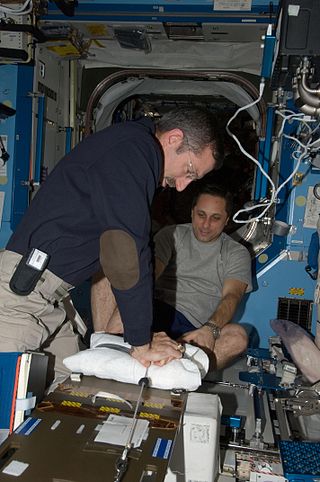
Space medicine is a specialized field, which developed from Aerospace medicine, that focuses on the acute medical care of astronauts and spaceflight participants. The spaceflight environment poses many unique stressors to the human body, including G forces, microgravity, unusual atmospheres such as low pressure or high carbon dioxide, and space radiation. Space medicine applies emergency medicine, acute care medicine, critical care medicine, interventional radiology, radiology, austere medicine, and toxicology perspectives treat and prepare for medical problems in space. This expertise is then used to inform vehicle systems design to minimize the risk to human health and performance while meeting mission objectives.
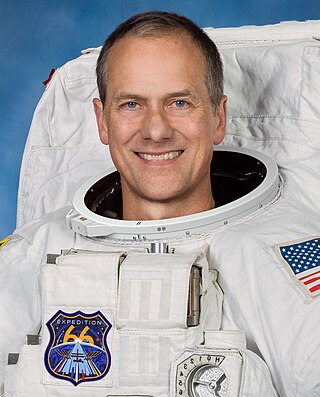
Thomas Henry Marshburn is an American physician and a former NASA astronaut. He is a veteran of three spaceflights to the International Space Station and holds the record for the oldest person to perform a spacewalk at 61 years old.

Michael Reed Barratt is an American physician and a NASA astronaut. Specializing in aerospace medicine, he served as a flight surgeon for NASA before his selection as an astronaut, and has played a role in developing NASA's space medicine programs for both the Shuttle-Mir Program and International Space Station. His first spaceflight was a long-duration mission to the International Space Station, as a flight engineer in the Expedition 19 and 20 crew. In March 2011, Barratt completed his second spaceflight as a crew member of STS-133. Barratt will pilot the SpaceX Crew-8 mission in spring 2024.
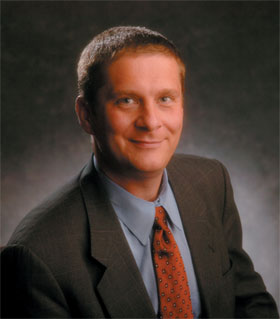
Timothy J. Broderick, F.A.C.S., is Professor of Surgery and Biomedical Engineering at the University of Cincinnati, where he has served on the faculty since 2003. He also serves as Chief of the Division of Gastrointestinal and Endocrine Surgery and is Director of the Advanced Center for Telemedicine and Surgical Innovation (ACTSI). He has flown on the NASA KC-135 parabolic laboratory and dived in the NASA Extreme Environment Mission Operations (NEEMO) program to develop advanced surgical technologies for long duration space flight.
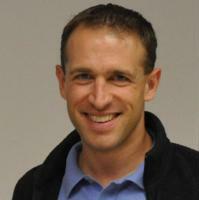
Christopher E. Gerty is an American aerospace engineer who worked on NASA's Constellation Program. Gerty is an advocate of NASA's Open Government Initiative and is a leading voice on the concept of participatory exploration and collaboration. He has fifteen years of experience working on complex, technology-intense projects at NASA. Gerty served as an aquanaut on the NASA Extreme Environment Mission Operations 13 crew.

William Laurence Todd is a Project Manager for Exploration Analogs at NASA's Johnson Space Center (JSC) in Houston, Texas. He has also served as a NASA Undersea Research Team Project Lead and Spaceflight Training Simulation Supervisor at NASA JSC. Todd is a veteran Aquanaut of 5 missions. In 2001, he commanded the first NASA Extreme Environment Mission Operations (NEEMO) mission, a joint NASA-NOAA program to study human survival in the Aquarius underwater laboratory in preparation for future space exploration.
It is inevitable that medical conditions of varying complexity, severity and emergency will occur during spaceflight missions with human participants. Different levels of care are required depending on the problem, available resources and time required to return to Earth.
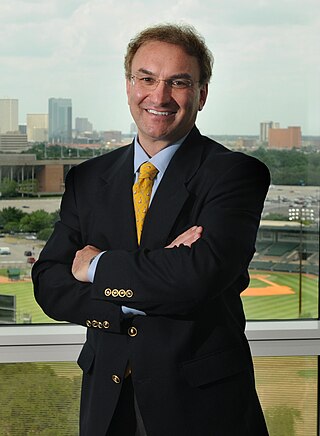
Jeffrey Paul Sutton is a Canadian-American physician-scientist who holds the Friedkin Chair for Research in Sensory System Integration and Space Medicine at Baylor College of Medicine (BCM), where he is the founding Director and Professor in the Center for Space Medicine. He is also Chairman of the Board of the Translational Research Institute for Space Health that is part of the Human Research Program of the National Aeronautics and Space Administration. Sutton is the former Chief Executive Officer, President and Institute Director of the National Space Biomedical Research Institute.
The Astromaterials Research and Exploration Science (ARES) Directorate performs the physical science research at the Johnson Space Center (JSC). It serves as the JSC focus for support to the HQ Science Mission Directorate. ARES scientists and engineers also provide support to the human and robotic spaceflight programs with expertise in orbital debris modeling, analysis of micrometeoroid/orbital debris risks to spacecraft, image analysis and Earth observations. The responsibilities of ARES also include interaction with the Office of Safety and Mission Assurance and the Human Space Flight Programs. They perform research in Earth, planetary, and space sciences and have curatorial responsibility for all NASA-held extraterrestrial samples.
The University of Maryland, Baltimore County (UMBC) features a variety of research centers and institutes both based on the campus and affiliated with other academic institutions. These centers and institutes listed below seek out to expand their research, educate, and promote partnerships between the university and the Baltimore-Washington Metropolitan Area and beyond.

The BioScience Research Collaborative (BRC) is a collaborative life science research building in the Texas Medical Center in Houston, Texas. It is similar in concept to the Clark Center/BioX at Stanford University and the Broad Institute at MIT, among other collaborative centers. After Rice University President David Leebron announced his "Vision for the Second Century," including plans to increase research funding, build up existing programs, and increase collaboration between Rice and other entities, the construction of the BRC went forward with the intention of fostering collaboration with the neighboring Texas Medical Center. The BRC was built by Rice University, and officially opened in April 2010. A unique characteristic of the BRC as compared to other academic research institutes is the shared research space by faculty from Rice University and groups from neighboring Texas Medical Center institutions. Collaborative research provides an advantage over traditional research in that multiple professors, or principal investigators, and their laboratory groups work together on different aspects of the same problem which usually results in finding a solution in a shorter amount of time.,

Since its establishment in 1958, NASA has conducted research on a range of topics. Because of its unique structure, work happens at various field centers and different research areas are concentrated in those centers. Depending on the technology, hardware and expertise needed, research may be conducted across a range of centers.
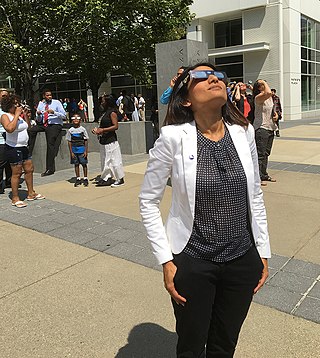
Dr. Mamta Patel Nagaraja is an American engineer and scientist, and currently the Associate Chief Scientist for Exploration and Applied Research. In this role, she advises NASA's chief scientist on missions where humans perform science in spaceflight. She has degrees in aerospace engineering, mechanical engineering, and biomedical engineering. Her dissertation research was in molecular biology where she studied genetic changes in bone cells exposed to simulated microgravity. She previously received two interviews to become a NASA astronaut, served on the NASA Administrator’s team, led a science communications portfolio, and served on a White House Council.
Mark J. Shelhamer is an American human spaceflight researcher specializing in neurovestibular adaptation to space flight., and former chief scientist of NASA's Human Research Program. He is a Professor of Otolaryngology - Head and Neck Surgery at the Johns Hopkins School of Medicine, director of the Human Spaceflight Lab at Johns Hopkins, and director and founder of the Bioastronautics@Hopkins initiative. He is also an adjunct associate professor at George Washington University School of Medicine and Health Sciences. He has published over 70 scientific papers and is the author of Nonlinear Dynamics in Physiology: A State-Space Approach. He holds several patents for various vestibular assessment devices.

Carolyn Leach Huntoon is an American scientist and former government official. She was the director of the Johnson Space Center in Houston, Texas, a position which she held from 1994 to 1996, and was the first woman in the role. She was an assistant secretary at the Department of Energy from 1999 to 2001.
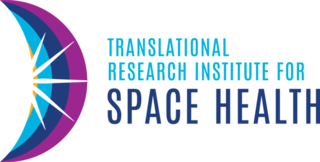
The Translational Research Institute for Space Health (TRISH) is a virtual, applied research consortium that pursues and funds translational research and technologies to keep astronauts healthy during space exploration, with the added benefit of potential applications on Earth. TRISH is specifically focused on human health in preparation for deep space exploration efforts, including National Aeronautics and Space Administration's (NASA) Artemis missions to the Moon, and future human missions to Mars. TRISH also supports research to collect and study biometric data gathered on commercial spaceflight missions to better understand the effect of spaceflight on the human body.
References
- ↑ Joshua, Buck (23 March 2012). "CONTRACT RELEASE : C12-013, NASA Extends Cooperative Agreement With NSBRI". National Aeronautic and Space Administration. Retrieved 28 September 2016.
- ↑ NASA Office of Inspector General (February 2018). "NASA OIG: Audit of the National Space Biomedical Research Institute". SpaceRef. Retrieved April 7, 2021.
- ↑ "National Space Biomedical Research Institute: 1997-2017". NSBRI. Retrieved April 7, 2021.
- ↑ NASA (2016). "Human Research Program Annual Report, FY 2016: Advancing Human Exploration" (PDF). Nasa.gov. pp. 4, 10. Retrieved April 7, 2021.
- ↑ "2007 Stellar Awards Winners". Rotary National Award for Space Achievement.